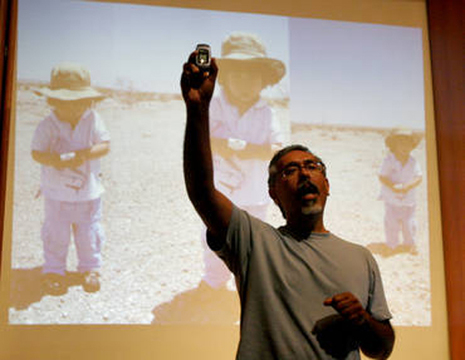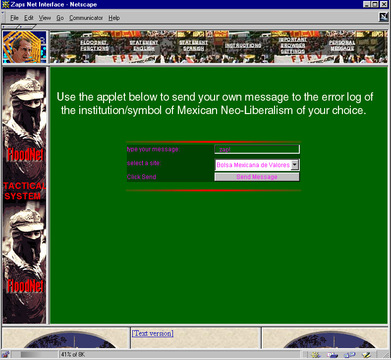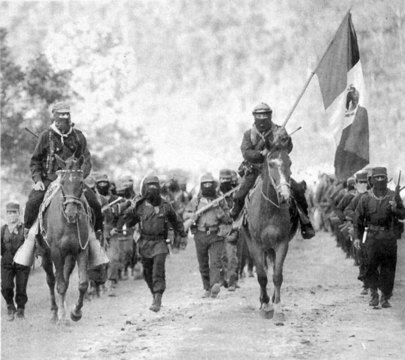Search results for 'zapatista'
Subcomandante Marcos
Subcomandante Marcos (Date of birth unknown), is the spokesperson for
the Zapatista Army of National Liberation (EZLN), a Mexican rebel
movement. In January 1994, he led an army of Mayan farmers into the
eastern parts of the Mexican state of Chiapas protesting against the
Mexican government's treatment of indigenous peoples.
Ricardo Dominquez
Ian Alan Paul
Ian Alan Paul is a transdisciplinary artist, theorist, and curator. His practice includes the production of experimental documentary, critical fiction, and media art, aiming to produce novel conditions for the exploration of contemporary politics, ethics, and aesthetics in global contexts. His projects have approached a wide variety of topics including the Guantanamo Bay Prison, Fortress Europe, the Zapatista communities, Drone Warfare, the military regime in post-revolution/post-coup Cairo, and most recently with the history and future of Palestine.
ReadRicardo Dominguez
Ricardo Dominguez is a co-founder of The Electronic Disturbance Theater (EDT), a group who developed Virtual-Sit-In technologies in 1998 in solidarity with the Zapatista communities in Chiapas, Mexico. He is co-Director of Thing (thing.net) an ISP for artists and activists.
Brett Stalbaum
Brett Stalbaum is an artist and research theorist specializing in information
theory, database, and software development. A serial collaborator, he
was a co-founder of the Electronic Disturbance Theater in 1998, for
which he co-developed software called FloodNet (http://www.thing.net/~rdom/ecd/ecd.html),
which has been used on behalf of the Zapatista movement against the
websites of the Presidents of Mexico and the United States, as well as
the Pentagon. As Forbes Magazine put it "Perhaps the first electronic
attack against a target on American soil was the result of an art
project." For EDT, this was all learned behavior taught by the example
of the Zapatistas. Stalbaum has been part of many other individual and
collaborative projects, and has published widely on digital art, its
context and aesthetics, and location aware media. He is a past editor
of Switch, the new media journal of the CADRE digital media lab.
Tactical Media Futures
A conversation between the Electronic Disturbance Theater & Ian Alan Paul
Khalil Sakakini Cultural Center
مركز خليل السكاكيني الثقافي
Wednesday, March 22nd, 6:30pm
Khalil Sakakini Str. Al Masyoon, Ramallah, Palestine
Wednesday, March 22nd, 6:30pm
Antisocial Media
“Antisocial Media” is a remix/cut-up/utopian-plagiarism of Guy Debord’s 1967 “The Society of the Spectacle” that reflects on the role of the network and (anti)social media in political, economic, and everyday life.
ReadThe Zapatista Tactical FloodNet
A collaborative, activist and conceptual art work of the net
The Twitter Revolution Must Die
Have you ever heard of the Leica Revolution? No?
The Fascist Simulation
In the United States, fascism presently unfolds as a simulation. The fascist simulation constitutes itself as a pixelated sea of livestreams, images, posts, and comments, circulating widely as its own networked, autonomous model of reality. It is enacted as an ensemble of people, social media platforms, presidential tweets, superspreader events, confederate flags, television chyrons, informatic infrastructures, automatic rifles, toxic masculinities, MAGA hats, racist hashtags, and video game servers. It is fascist ideology reified through consumer technology.
ReadThe Transborder Immigrant Tool: Violence, Solidarity and Hope in Post-NAFTA Circuits of Bodies Electr(on)/ic
This polyvocal, collectively authored paper describes the Transborder Immigrant Tool, a border disturbance art project developed by the Electronic Disturbance Theater. The paper outlines the motivations behind the tool and elaborates a notion of Science of the Oppressed as a methodology for developing locative media projects in solidarity with social movements. A shift is identified from Tactical Media to Tactical Biopolitics in contemporary media art. Walkingtools.net is also introduced as a platform for sharing technical information about locative media projects in order to create an ecology of projects. Poetic sustenance, part of the Transborder Immigrant Tool's functioning, is discussed in a context of Inter-American Transcendentalism.
ReadThe Corona Reboot
An attempt to provisionally theorize the emergence of new subjectivities in the early stages of the coronavirus pandemic.
ReadTen Premises For A Pandemic
How much has changed in just a few days. Here is another text I've composed in an attempt to continue to think about the pandemic, and our lives within it. I hope it's of use, however minorly, as we all try to come to some kind of terms with the novel transformations, precarities, and struggles emerging in every direction.
~i
Holding Out for Un-alienated Communication
"In August 1996, we called for the creation of a network of independent media, a network of information. We mean a network to resist the power of the lie that sells us this war that we call the Fourth World War. We need this network not only as a tool for our social movements, but for our lives: this is a project of life, of humanity, humanity which has a right to critical and truthful information."
These were the words of Subcomandante Marcos, speaking in 1997 from Chiapas in the midst of the Zapatistas' guerrilla information war against the Mexican state and the neocolonialism reflected in NAFTA. Marcos's powerful statement and Zapatista stories of struggle were circulated from the jungle of Chiapas on mailing lists, listservs, and websites, capturing the imagination of activists around the world and galvanizing a wave of new grassroots media projects. Perhaps no project more purely embodied this response than the Indymedia network, which was launched in November 1999 at the Seattle protests against the World Trade Organization (WTO) meetings and quickly grew into a global network of news websites.
Can Internet technology still revolutionize activism?
One of the biggest promises of the Internet was the transformation of political activism. No longer would change come about solely through the actions of large organizations, claimed the Web's early enthusiasts. Now, they claimed, individuals could rouse the concern of their fellow citizens for a particular cause through Web sites, e-mail, and online petitions. Those who normally shunned demonstrations and limited their participation in the public sphere could be contacted personally in their e-mail box, and all that would be necessary for them to do to show their support would be to click a button or fill in a field. Soon, pundits predicted, there would be a revolution in grassroots participation in the political process.
ReadThe Fourth World War
The following text is an excerpt from a talk given by Subcomandante
Insurgente Marcos to the International Civil Commission of Human Rights
Observation in La Realidad, Chiapas on November 20, 1999. The outline
for the talk was published in Letters 5.1 and 5.2 in November of the
same year, with the titles "Chiapas: the War: 1, Between the Satellite
and the Microscope, the Other's Gaze," and 2, "The Machinery of
Ethnocide." Any similarity to the conditions of the current war is
purely coincidental. Published in Spanish in La Jornada, Tuesday,
October 23, 2001.





